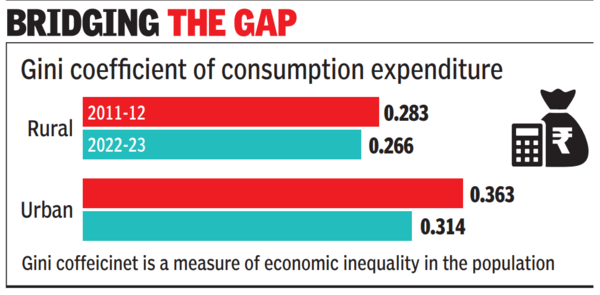The latest data is expected to add to the raging debate over the extent of inequality in the country with some experts saying it had increased while others have said that it has shown a decline after a spike during the Covid-19 pandemic period.
The Gini coefficient, a statistical measure of inequality in the population, shows a decline, from 0.283 to 0.266 for the rural sector and from 0.363 to 0.314 for the urban sector of the country, according to the survey results.
“A decline in the Gini coefficient across urban and rural areas suggests a reduction in income inequality between 2011-12 and 2022-23. Remarkably, income inequality has decreased both in industrially advanced states and in states that have not performed well in attracting businesses,” said Nilanjan Banik, professor of economics at Mahindra University.
The NSSO had earlier released a fact sheet on the household consumption expenditure data. While commenting on those numbers, Niti Aayog CEO B V R Subrahmanyam had said that based on the household consumption survey data the poverty level in the country could be closer to 5% or less.

The household consumption expenditure survey has been released after more than 10 years as the one in 2017-18 was put on the backburner due to inconsistencies in the data. The survey results are used to extrapolate poverty estimates, update GDP numbers.
“The survey reveals that the share of consumption at the bottom 50% fractile classes expanded faster in urban areas during FY12 and FY23 including those at the lowest pyramid at 0-5%. In rural areas, there was also a concomitant shift though the pace was slower. There is also a pronounced decline in estimated Gini coefficient in rural and urban areas over the period. Interestingly, across states for rural areas, the estimated Gini coefficient is higher than all India for states like Kerala, Maharashtra and Rajasthan. For urban areas, Haryana and Kerala have higher Gini coefficient than all India. Thus states seem to be doing better on an average in terms of distribution across rural and urban areas,” said Soumya Kanti Ghosh, group chief economic adviser at State Bank of India.
The results also showed the Gini coefficient for various states for both urban and rural areas. The survey for 2022-23 has undergone some changes in terms of coverage of items, change in questionnaire, multiple visits for data collection and mode of data collection which has prompted some experts to raise issues linked to comparing the results of the current survey with the previous ones.
The average estimated monthly per capita consumption expenditure (MPCE) in 2022-23 was Rs 3,773 in rural and Rs 6,459 in urban India.
“Thus, the per capita expenditure level in the urban areas, in nominal terms, and ignoring rural-urban differences in price levels, has been about 71% more than that in the rural areas,” according to the survey.
Among the major states, MPCE is the lowest in Chhattisgarh for rural (Rs 2,466) as well as urban (Rs 4,483) sectors. It is the highest in Kerala (Rs 5,924) in rural areas and Telangana (Rs 8,158) in urban areas. Separate surveys conducted by independent think tanks have shown a decline in inequality.
“India’s income inequality declined in 2022-23 for the first time since the pandemic, with the income Gini index decreasing by 23%, from 0.506 to 0.390. This improvement is primarily due to the significant recovery of the bottom 50% of households which include labourers, petty traders, small business owners, and small and marginal farmers, according to our ICE 360 survey,” said Rajesh Shukla, MD and CEO of PRICE, a private economic think tank. “Their share of total household income rose from 15.8% in 2020-21 to 22% in 2022-23. Govt welfare schemes introduced in response to the pandemic significantly contributed to the decrease in income inequality,” said Shukla.



)
)




